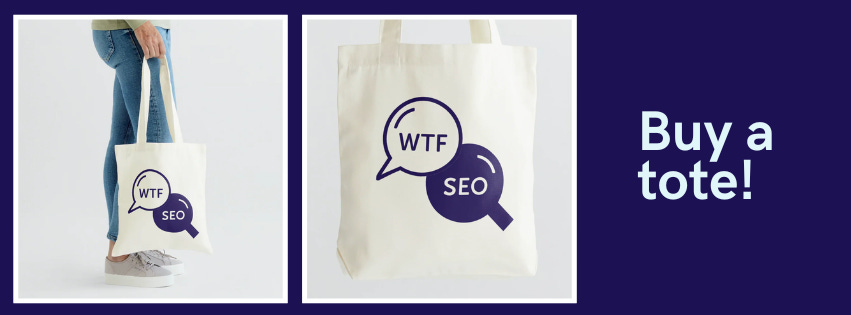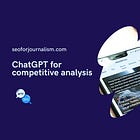What we learned at NESS 2025 (pt. 1)
We had such a great time at NESS 2025. Here’s part one of what we learned
Please help us get the totes out of Jessie’s house! She’s running out of room for yarn!

Hello, and welcome back. Jessie here, reporting live from the Eurostar somewhere between Brussels, Belgium and London. I was thrilled to spend the last week in Dortmund, Germany, participating in both virtual and IRL conferences! Germany is surprisingly vegan-friendly, and (unsurprisingly) full of lovely folks. And Pepsi Zero in a glass bottle is somehow a delight?
This week: What we learned at NESS – part one! We had such a great time learning at the fifth annual News and Editorial SEO Summit, hosted by our pals Barry Adams and John Shehata. We’ll be back next week with a recap of the remaining sessions.

Let’s get it.
THE HOW TO
What’s working in Google Discover in 2025?
Lily Ray, vice president of SEO strategy and research at Amsive, spoke about Google Discover, with a focus on headlines based on analysis of millions of URLs. Her research shows headlines that drive traffic in Discover have common patterns:
Authority figures: Headlines featuring individuals with a proven track record (e.g., “financial expert who predicted X” or “industry insider”) outperformed citing generic “experts.”
Numbers: Headlines with concrete and relatable data points (e.g., “this person saved $2,400 in 5 months”) had strong click-through rates.
Emotion: Headlines tapping into common fears, such as economic anxiety, had stronger engagement than more neutral options.
Controversy: Headlines with shocking information (e.g., someone refusing to evacuate during a hurricane) were shared more frequently than neutral informational reporting.
The optimal headline length for Google Discover is 90 to 105 characters, and never more than 130.
🔥 Hot tip: She shared a set of free tools on her website to generate and test Discover-optimized headlines, making use of the formula she outlined to rewrite headlines.
Lily concluded by discussing ways to future-proof your reach, including diversifying traffic sources beyond Google, treating journalists like creators and building their profile for off-platform audiences, and repurposing content across multiple formats (e.g., cutting a YouTube video into Instagram and TikTok videos). With these efforts, publishers can see their ideas surface wherever users (and AI models) are looking.
The future of search
In his keynote, CEO and founder of iPullRank Mike King explained how the future of search might look something like the Spike Jonze movie Her: a richer experience that takes into consideration location, natural language processing, machine learning, all the world’s information and a fast, good user experience.
“Users never wanted the 10 blue links,” he said, referring to the old search experience. “They wanted the Star Trek computer.”
Ultimately, the future of search will be a multimodal user experience that’s less about the search interface. While classic SEO is “deprecated, not dead,” AI Overviews are already splintering traffic. Zero-click results are rising, and impressions are often more valuable than clicks.
Search behavior is shifting to longer, multiplatform journeys — across Google, YouTube, TikTok, and Reddit — making visibility itself a brand-building act.
He urged marketers to embrace the concept of “relevance engineering” and upskilling for a generative AI future, noting that according to Stanford’s 2025 Al Index Report, 78% of global organizations are now using Al in production.
He criticized SEO as a “checklist culture” where people follow potentially outdated best practices and suggested instead engineering for relevance. “Now is the time to shed all the things that no longer serve us that we inherited in the SEO industry,” he concluded.
How will publishers make money now?
Harry Clarkson-Bennett, SEO director at The Telegraph, spoke about the revenue challenges facing publishers. Now that audiences are accustomed to getting information for free across platforms like YouTube, TikTok, or Twitter (X), publisher websites have become less essential — and less profitable.
Publishing has long been a tricky business to make profitable, and while some can rely primarily on advertising, most can’t, especially as it becomes easier to access barrier-free content. Revenue diversification has become essential.
Paywalls are the gold standard, Harry explained, as they enable a direct, predictable relationship with readers – and a consistent revenue stream.
To be successful, publishers must understand their audience, be distinct, and provide valuable content in multiple forms. Not everything should be paywalled: for example, content that’s easily replicable elsewhere isn’t high-value and shouldn’t necessarily be gated. Paywall only what’s unique and valuable.
Search traffic is unlikely to return to its old peak. Now, the role of SEOs is to add value to the business in other ways. Harry offered ways to be more commercially minded:
SEO still works. It’s getting harder to succeed on search, but there’s still real, lasting value in optimizing for search.
Collaborate with PPC (pay-per-click) teams because paid traffic tends to convert really well.
Maximize traffic value. Focus on extracting more from existing search audiences through smarter monetization and engagement. That includes personalized customer journeys or better advertiser or affiliate deals.
Build assets that are AI-resilient and relevant to your readers.
“Now, more than ever, our job is to help the business make good decisions,” Harry said.
Mastering the YouTube algorithm
Steve Wilson-Beales, content strategy and SEO consultant, discussed recent research showing that watching videos is now the primary activity people engage in online, while digital news consumption has begun to level off. For those publishers who can crack YouTube’s algorithm, there’s plenty of room for growth.
Creators on YouTube are currently filling an audience need: People want to consume information from people they trust – and they’re finding it on YouTube. If publishers can crack the YouTube algorithm, they can meet that need.
To optimize for longer-form YouTube, publishers need to:
Do keyword research in advance. Google Trends filtered by YouTube, and the search function (autocomplete) on YouTube. Consider the keywords you, a user, would type to find this find. Review both the primary and secondary keywords to use in the title and description;
Titles should be clear, short, and specific while also adding personality and carrying emotion. Avoid clickbait in headlines – and don’t let a really great title get watered down by cramming in keywords.
Thumbnails should have bright, bold images with the central figure or figures in the foreground. Text must be really concise – users are sometimes more interested in that text than the video’s title tag itself.
Make use of tags and the description to give YouTube and users relevant data (and links).
Captions and transcripts all help ranking – but they won’t turbocharge a weak video.
Steve concluded by saying that with consumption on the rise, publishers should experiment more with video formats to reach new audiences.
AI agents for news SEO
James Carson, the founder of Absolutely Agentic, discussed how AI tools can take what’s normally a time-intensive task – writing a morning trending news email — and automate it end-to-end.
Often, audience teams spend hours scouring Google Trends for insights, checking competitor sites for gaps, and drafting summaries.
Using AI tools, it’s possible to deploy an agent to gather and filter data and then format the results into an email digest for editors. What once took hours of manual research now runs in minutes.
The lesson from James: if you’re going to pursue automation in the newsroom, start with repetitive, variable tasks — where AI tools can handle the heavy lifting, and humans keep control of editorial judgment.
Ask the SEOs: What’s next for search?
NESS featured an all-star panel of Kevin Indig, author of the Growth Memo, Barry Schwartz, the prolific Search Engine Roundtable writer, and Mike King, who also gave the keynote address. Here are some highlights from the session:
SEOs are expected to know a lot: data analysis, how LLMs work, technical SEO. Are we asking too much?
Kevin said SEOs should understand the basic concepts (e.g., how LLMs work), but depending on where you work, what you need to know will vary.
Barry Adams said almost everyone can make a go of working in SEO because it requires a wide range of skills, backgrounds and offers varied opportunities. Being specialized and having specific skills can be advantageous.
Should brands invest heavily in AI?
Kevin tells his clients to monitor and track their SEO performance, and said that sites doing good SEO are most likely in a solid position. He suggests leveraging the current hype around AI search is an opportunity to get other existing SEO initiatives prioritized.
The bottom line: News SEO is constantly changing – that’s why it’s exciting. Publishers should intentionally distribute their content across platforms, reduce their reliance on search traffic, and diversify their revenue mix.
#SPONSORED - The Classifieds
Get your company in front of more than 13,000 writers, editors and digital marketers working in news and publishing. Sponsor the WTF is SEO? newsletter!
RECOMMENDED READING
Google news and updates
🤖 Matt G. Southern for Search Engine Journal: Google rolled out AI trending previews in Discover.
🤖 Barry Schwartz for Search Engine Roundtable: Google says links, site moves or technical SEO won’t fix your rankings if you have overall quality issues with your site.
Even more recommended reading
⌨️ OpenAI: OpenAI released its browser with ChatGPT, called ChatGPT Atlas.
💬 Matt G. Southern for Search Engine Journal: A cross-market study of 2,709 AI assistant responses showed they had significant issues providing accurate news answers.
Wikipedia reports its traffic is down and cites AI-powered answers as the reason.
Here are 17 well- and less-known reports to track in 2025.
💼 Danny Goodwin for Search Engine Land: Reddit sues Perplexity, SerpApi over scraping Google Search data
📲 Matt Karolian: The Washington Post can’t replace its TikTok Guy.
🎵 Lauren Forristal for TechCrunch: How to use the new ChatGPT app integrations (Spotify, Figma, Canva, etc).
What did you think of this week’s newsletter?
(Click to leave feedback.)
Catch up: Last week’s newsletter
Have something you’d like us to discuss? Send us a note on Twitter (Jessie or Shelby) or to our email: seoforjournalism@gmail.com.
Written by Jessie Willms and Shelby Blackley







Excellent recap! I found Lily Ray's insights on Google Discover headlines especially compelling; it's cool to see data-driven strategies for content. It's always great to hear about actual research rather then just guesses, so this gives me a lot to think about.
Thank you for this! I’m an audience engagement editor in a small newsroom in Sacramento, California. Can you elaborate on the character guidance for Discover? Do you have recommendations as to how to balance that guidance with competing best practices for search and social?
As a small, public media shop, we really rely on your Substack as a resource for SEO. Thank you!